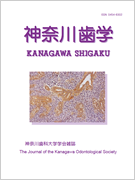- HOME
- > 一般の方
- > バックナンバー:神奈川歯学
- > 58巻2号
- > アブストラクト
アブストラクト(58巻2号:神奈川歯学)

Japanese
| Title : | MFTによって被蓋改善を行った反対咬合症例 |
|---|---|
| Subtitle : | 症例・臨床報告 |
| Authors : | 小野崎純1), 大塚未紗2), 杉田武士3), 有坂博史3), 不島健持4) |
| Authors(kana) : | |
| Organization : | 1)神奈川歯科大学歯学部歯科矯正学講座高度先進歯科矯正学分野, 2)神奈川歯科大学歯学部歯科診療支援学講座高度先進歯科メンテンナンス学分野, 3)神奈川歯科大学歯学部麻酔科学講座高度先進麻酔科学分野, 4)神奈川歯科大学歯学部 |
| Journal : | 神奈川歯学 |
| Volume : | 58 |
| Number : | 2 |
| Page : | 114-119 |
| Year/Month : | 2023 / 12 |
| Article : | 報告 |
| Publisher : | 神奈川歯科大学学会 |
| Abstract : | 「緒言」反対咬合は, 混合歯列期において高頻度に遭遇する不正咬合の一つである. 混合歯列期の反対咬合の成立には, 低位舌, 舌突出癖等の機能的要因が大きく関与していると思われる例が散見される. 口腔筋機能療法(oral myofunctional therapy, MFT)は正しい舌位や舌の動きを獲得し, 安静時, 嚥下時に舌, 口腔周囲筋の協調した機能を獲得するために行われる運動療法である. MFTは不正咬合の一因となる不正な舌位や舌突出癖を是正し, 円滑な矯正治療の進行, 治療後の安定性を向上させるために矯正治療の一環として行われている. 今回, 低位舌, 舌突出癖が認められた反対咬合症例において, 器械的矯正装置を用いずに, MFTによる機能的アプローチで被蓋が改善し, 良好な結果を得た症例を経験した. また, MFTの施行にともない, 舌圧の変化を測定し, 若干の知見が得られたので報告する. 「症例」「1. 初診時年齢」7歳1か月. |
| Practice : | 歯科学 |
| Keywords : | MFT, 反対咬合, 舌突出癖, 舌圧 |
English
| Title : | Case report of reversed occlusion that improved a tegmentum by oral myofunctional therapy |
|---|---|
| Subtitle : | |
| Authors : | Jun ONOZAKI1), Misa OTSUKA2), Takeo SUGITA3), Hirofumi ARISAKA3), Kenji FUSHIMA4) |
| Authors(kana) : | |
| Organization : | 1)Department of Orthodontics and Dentofacial Orthopedics, School of Dentistry, Kanagawa Dental University, 2)Department of Oral Health Care, School of Dentistry, Kanagawa Dental University, 3)Department of Anesthesiology, School of Dentistry, Kanagawa Dental University, 4)School of Dentistry, Kanagawa Dental University |
| Journal : | Kanagawa Shigaku |
| Volume : | 58 |
| Number : | 2 |
| Page : | 114-119 |
| Year/Month : | 2023 / 12 |
| Article : | Report |
| Publisher : | Kanagawa Odontological Society |
| Abstract : | [Abstract] Oral myofunctional therapy (MFT) is an exercise therapy carried out to acquire proper position and movement of the tongue in order to ensure coordinated function of the tongue and perioral muscles at rest and during swallowing. MFT is carried out as part of orthodontic therapy to correct tongue malposition and tongue protrusion habit that can be causes of malocclusion, to not only facilitate smooth progression of the orthodontic therapy, but also improve post-therapy stability. We experienced a case of anterior crossbite showing low tongue position and tongue protrusion habit in which occlusal improvement was obtained by a functional approach through MFT without the use of a mechanical orthodontic appliance. The results in this case demonstrate that utilizing MFT to correct low tongue position and eliminate detrimental oral habits such as tongue protrusion is useful for improving functional malocclusion. Measurement of changes in maximum tongue pressure from the start of MFT also showed that occlusal improvement was accompanied by an increase in maximum tongue pressure. This finding suggests that tongue pressure measurements may facilitate objective evaluation of MFT. |
| Practice : | Dentistry |
| Keywords : | MFT |
